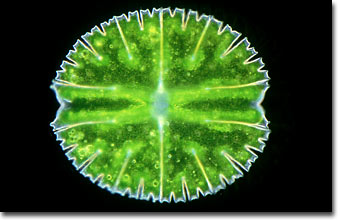Spike (M.I.) Walker
Desmid Algae (Micrasterias rotata)
English photomicrographer Spike (M.I.) Walker has been a consistent winner of the Nikon Small World competition for many years and has published many articles and a book about microscopy. Featured below is a photomicrograph of the desmid algae Micrasterias rotata, taken with darkfield illumination.

|
The specimen was taken from an almost pure culture in a flooded hoof print, which was also home to several frog tadpoles. The objective utilized to capture this photomicrograph was 25/0.65 planapochromat coupled to a dry darkfield condenser. Illumination was provided by a 12-volt 100-watt tungsten halide lamp. The microscope was a Zeiss Ultraphot III equipped with an automatic 35 millimeter photohead. The film was Fujichrome Velvia. (63x) |
Organisms belonging to the genus Micrasterias are desmids, microscopic green algae that occur in all types of freshwater habitats around the world, usually in acid bogs or lakes. Only a few genera are found in alkaline waters. They thrive in waters that are deficient in nutrients, which is being threatened in many areas because of fertilizer run-off from residential and agricultural areas.
Desmids are characterized by extensive variation in cell shape and are typically one-celled, though sometimes filamentous or colonial. Each organism is divided symmetrically into two symmetrical halves, held together by an isthmus containing the nucleus. Each half of the cell has a single chloroplast. Micrasterias rotata is one of the largest desmids, and can occur as large as one-third of a millimeter.
The cell wall is composed of three layers impregnated with openings or pores and pectin spicules. Many species are phototropic and are capable of moving towards light by extruding a gelatinous substance through these pores. Desmids reproduce both sexually and asexually. Asexually, they reproduce by a simple division. Sexually, they reproduce either through conjugation, a means of exchanging nuclear material between two organisms, or by fusion -- when two organisms fuse to form a single new organism. Spores are rare.
